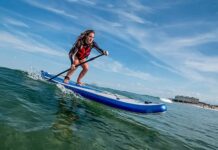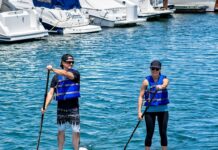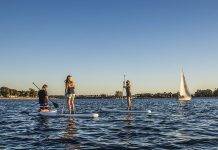When it comes to paddling your way to fitness on a Stand-Up Paddleboard (SUP), the question of whether or not you need special shoes or footwear is a common one.
As passionate SUP enthusiasts, we understand the importance of finding the perfect gear for a safe and enjoyable workout. In this article, we’ll explore the advantages of investing in proper footwear for SUP fitness and how it can enhance your experience on the water.
So, if you’re wondering whether those old sneakers or flip-flops will do the trick, read on to discover the benefits of specialized shoes designed specifically for SUP fitness.
What is SUP Fitness?
SUP Fitness, short for Stand-Up Paddleboard Fitness, is a unique exercise that combines the exhilarating experience of stand-up paddleboarding with a full-body workout. It involves performing various fitness activities and exercises on a paddleboard while floating on water. SUP Fitness has gained immense popularity in recent years due to its ability to provide a challenging workout while also allowing practitioners to connect with nature and enjoy the serene beauty of the water.
Definition of SUP Fitness
SUP Fitness can be defined as a fitness routine performed on a paddleboard, which incorporates a variety of exercises, such as yoga, pilates, strength training, and cardio exercises. It requires balance, coordination, and core strength to maintain stability on the paddleboard while engaging in these exercises. SUP Fitness can be practiced on lakes, rivers, and the ocean, offering a refreshing and stimulating outdoor workout experience.
Benefits of SUP Fitness
Engaging in SUP Fitness offers a myriad of benefits for both the mind and the body. Firstly, it provides an excellent cardiovascular workout, as paddling against the resistance of the water requires sustained effort and helps to improve cardiovascular endurance. Additionally, the instability of the paddleboard engages multiple muscle groups, including the core, legs, arms, and back, resulting in increased overall strength and toning.
Furthermore, SUP Fitness is a low-impact activity which puts minimal strain on the joints and reduces the risk of injuries commonly associated with high-impact exercises. This makes it suitable for people of all ages and fitness levels, including those recovering from injuries or joint issues.
Another notable benefit of SUP Fitness is its ability to enhance mental well-being. Being surrounded by water and nature promotes a sense of tranquility and calms the mind, reducing stress and improving overall mental health. The soothing sound of water and the fresh air create a serene atmosphere that can help alleviate anxiety and improve mood.
Rise in Popularity
Over the past decade, SUP Fitness has experienced a significant rise in popularity, with more and more people recognizing the numerous benefits it offers. The blend of outdoor adventure, physical fitness, and mindfulness that stand-up paddleboarding provides has captured the attention of fitness enthusiasts, outdoor enthusiasts, and individuals simply looking for a new and fun way to stay active.
Additionally, the accessibility and versatility of SUP Fitness have contributed to its surge in popularity. Practitioners can enjoy this activity in various settings, from calm lakes to challenging ocean waves, and it can be modified to suit different fitness levels and preferences. Moreover, the social aspect of SUP Fitness, such as group classes and paddleboarding communities, has fostered a sense of camaraderie and further motivated individuals to participate.
Importance of Footwear in SUP Fitness
When engaging in SUP Fitness, proper footwear is essential to ensure safety, enhance performance, and provide optimal comfort during the workout. The proper footwear can protect the feet from potential hazards, offer stability and grip on the paddleboard, and prevent discomfort or injuries that may hinder the overall experience.
Protection and Support
One of the primary functions of SUP Fitness footwear is to protect the feet. While paddleboarding, the feet may come into contact with various elements, such as rocks, shells, or even marine life. Therefore, wearing shoes designed explicitly for SUP Fitness can safeguard the feet from potential cuts, abrasions, or punctures.
In addition to protection, proper footwear also provides essential support to the feet and ankles. The unstable nature of the paddleboard can challenge the body’s balance, and having shoes with adequate support can help stabilize the feet and reduce the risk of sprains or strains.
Grip and Stability
Maintaining stability on the paddleboard is crucial during SUP Fitness. The proper footwear should offer excellent grip on the board’s surface, ensuring the feet stay firmly in place, even in wet or slippery conditions. This grip can help prevent slips or falls, allowing individuals to focus on their workout without worrying about losing their footing.
Comfort and Fit
Comfort and fit are essential considerations when choosing SUP Fitness footwear. Ill-fitting or uncomfortable shoes can lead to blisters, discomfort, or even foot pain, which can distract from the enjoyment of the activity. Investing in footwear that provides a snug yet comfortable fit can ensure a pleasant and comfortable workout experience.
Characteristics of SUP Fitness Shoes
SUP Fitness shoes possess specific characteristics that make them suitable for this unique activity. These features ensure that the footwear is optimized for performance and functionality in water-based workouts.
Water Resistance
SUP Fitness shoes are designed to be water-resistant, which means they are capable of repelling water and preventing saturation. This characteristic allows the shoes to dry quickly and prevents them from becoming heavy or waterlogged during the workout. It also helps to maintain the shoes’ durability, as they are less prone to damage from constant exposure to water.
Quick Drying
In addition to being water-resistant, SUP Fitness shoes are typically made from materials that facilitate quick drying. This is crucial in preventing discomfort and the development of odor-causing bacteria. Quick-drying shoes ensure the feet remain dry and provide a hygienic environment, especially during extended workouts or hot weather conditions.
Lightweight
Given the dynamic nature of SUP Fitness, the footwear needs to be lightweight. Light shoes ensure that the feet are not burdened by excess weight, allowing for greater agility and ease of movement on the paddleboard. The lightweight nature of SUP Fitness shoes enhances comfort and reduces fatigue during longer workout sessions.
Flexible Sole
SUP Fitness shoes have flexible soles that allow for natural foot movement and provide optimal grip on the paddleboard. The flexibility enables the feet to adapt to the surface of the board and helps with maintaining stability. The sole should balance flexibility and support, providing a solid foundation for various exercises while allowing the feet to move naturally.
Good Traction
Traction is a vital characteristic of SUP Fitness shoes, ensuring a secure grip on the paddleboard. The shoe’s outsole should have a pattern or texture that enhances grip, preventing slips or falls. Durable and robust rubber outsoles offer excellent traction on wet surfaces, ensuring stability and safety during SUP Fitness workouts.
Considerations for Choosing SUP Fitness Shoes
Choosing the right SUP Fitness shoes can enhance the overall experience and ensure optimal performance and safety. Several factors should be considered when selecting footwear for this activity, including intended use, water conditions, budget, foot type, and personal preference.
Intended Use
The first consideration when choosing SUP Fitness shoes is the intended use. Different individuals may have specific goals or preferences for their workouts. For instance, some may focus on yoga-inspired exercises on the paddleboard, while others may prioritize high-intensity cardio workouts. Understanding the primary purpose of the shoes will help narrow down the options that best suit the individual’s needs.
Water Conditions
Water conditions are crucial in determining the type of SUP Fitness shoes. If the workouts primarily occur in calm, still waters such as lakes or ponds, shoes with minimal water resistance may be sufficient. However, for those engaging in SUP Fitness in rivers or coastal areas with potentially rough conditions, shoes with higher water resistance and better grip are recommended.
Budget
Budget is another important consideration when purchasing SUP Fitness shoes. While it is essential to invest in high-quality and durable footwear, it is also crucial to find options that align with one’s budget. Fortunately, various SUP Fitness shoe options are available at various prices, allowing individuals to find suitable footwear without compromising their financial constraints.
Foot Type
Understanding one’s foot type can significantly assist in selecting the right SUP Fitness shoes. Some individuals may have high arches, while others may have flat feet, and different shoes offer varying levels of arch support. It is important to choose footwear that matches the individual’s foot type to ensure proper alignment, support, and comfort.
Personal Preference
Finally, personal preference should also be considered when choosing SUP Fitness shoes. Some individuals may prefer a specific style or design, while others may prioritize certain features, such as lacing systems or colors. Considering personal preferences can add to the enjoyment of the overall workout experience.
Types of SUP Fitness Footwear
Regarding SUP Fitness footwear, there are various options available, each with its unique features and suitability for different preferences and conditions.
Water Shoes
Water shoes are a popular choice for SUP Fitness due to their versatility and functionality. These shoes are designed specifically for water activities, providing excellent grip, resistance, and quick-drying capabilities. They often feature a lightweight construction, flexible soles, and good arch support, making them suitable for a wide range of activities on the paddleboard.
Neoprene Booties
Neoprene booties are another standard option for SUP Fitness, particularly in colder water conditions. These booties are made from neoprene material, which offers thermal insulation and protects the feet from cold water temperatures. Neoprene booties also provide good grip and stability on the paddleboard, making them ideal for those who plan to engage in SUP Fitness in cooler climates or during the colder months.
Aqua Socks
Aqua socks, also known as water socks or water shoes, offer a minimalistic and lightweight option for SUP Fitness enthusiasts. These socks are typically made from soft and stretchy materials, providing a comfortable and sock-like fit. While they may not offer as much support or protection as other footwear options, they are ideal for individuals who prefer a barefoot-like experience while still providing some grip and protection against minor hazards.
Minimally Cushioned Shoes
Minimally cushioned shoes are designed to balance barefoot-like sensations and the protection and support of traditional athletic shoes. These shoes often have thin soles and lightweight construction, providing excellent flexibility and mobility on the paddleboard. Minimally cushioned shoes are suitable for individuals who prefer a closer-to-the-ground feel, allowing them to connect more intimately with the paddleboard.
Closed-Toe Sandals
Closed-toe sandals are a durable and versatile option for SUP Fitness footwear. They balance protection and breathability, providing coverage to the toes while allowing air to circulate. Closed-toe sandals often feature adjustable straps, enabling a customized and secure fit. These sandals are ideal for individuals who prefer the convenience of easy on and off while still having dependable traction and protection.
Pros and Cons of Different SUP Fitness Footwear
Each type of SUP Fitness footwear comes with its own set of advantages and considerations. Understanding the pros and cons can help individuals make an informed decision based on their specific needs and preferences.
Water Shoes
Pros:
- Excellent grip and stability on the paddleboard.
- Water-resistant and quick-drying.
- Protects from potential hazards.
- Versatile for various water activities.
- Offer good arch support and cushioning.
Cons:
- It may not provide as much ground feel as other options.
- It can feel bulky for individuals seeking a minimalist experience.
Neoprene Booties
Pros:
- Offers thermal insulation in colder water conditions.
- Provides grip and stability on the paddleboard.
- Protects feet from sharp objects.
- Good water resistance and quick drying.
Cons:
- It may feel restrictive or less breathable compared to other options.
- Less versatile for warm water conditions.
Aqua Socks
Pros:
- Provides a barefoot-like experience.
- Lightweight and minimalistic.
- It allows air circulation and quick drying.
- Easy to pack and travel with.
- Affordable option.
Cons:
- Less protection and support compared to other options.
- Limited durability in rough water conditions.
- It may not provide sufficient grip for intense workouts.
Minimally Cushioned Shoes
Pros:
- Offers a closer-to-the-ground feel.
- Lightweight and flexible.
- Allows good mobility and agility.
- Provides some foot protection.
- Suitable for individuals seeking a minimalist experience.
Cons:
- It may not provide as much cushioning or support as other options.
- It is less suited for individuals with foot conditions or needing more excellent arch support.
Closed-Toe Sandals
Pros:
- Provides coverage and protection for the toes.
- Versatile for various activities on and off the paddleboard.
- It offers an adjustable fit and convenience.
- Good breathability and ventilation.
Cons:
- It may have less grip compared to other options.
- Limited protection for the entire foot.
- Potential for debris or sand to enter the footwear.
Potential Risks of Inappropriate Footwear in SUP Fitness
Using inappropriate footwear for SUP Fitness can pose several risks and challenges that can potentially negatively impact the overall experience and safety of the individual.
Slips and Falls
Wearing footwear without proper grip and traction significantly increases the risk of slips and falls. The unstable surface of the paddleboard, coupled with water and potential hazards, makes it crucial to choose footwear with adequate traction to maintain stability and prevent accidents.
Lack of Support
Insufficient support from footwear can lead to various problems, such as foot fatigue and muscle strain. The repetitive movements and demands of SUP Fitness require footwear that offers proper arch support, stability, and impact absorption to protect the feet and prevent discomfort or injuries.
Foot Injuries
Without appropriate protection, the feet are vulnerable to cuts, scrapes, punctures, and other injuries. The potential hazards present in the water, such as rocks, shells, or marine life, can cause serious harm if the feet are left exposed. Utilizing footwear explicitly designed for SUP Fitness can significantly reduce the risk of foot injuries.
Decreased Performance
Using footwear that is ill-suited for SUP Fitness can hinder performance and limit the effectiveness of workouts. The discomfort or lack of stability caused by improper shoes can prevent individuals from fully engaging in their exercises, resulting in reduced workout intensity and suboptimal results.
Tips for Choosing the Right SUP Fitness Shoes
To ensure a safe and enjoyable SUP Fitness experience, consider the following tips when selecting footwear:
Consider the Activity Level
Determine the intensity and type of SUP Fitness activities you plan to engage in. If you prefer relaxed paddleboard yoga sessions, shoes with minimal grip may suffice. However, if high-intensity workouts or challenging water conditions are part of your routine, choose shoes with excellent grip, water resistance, and stability.
Assess the Water Conditions
Evaluate the water conditions you will likely encounter during your SUP Fitness sessions. If you primarily paddle in calm waters, shoes with minimal water resistance may be suitable. However, rougher waters or colder temperatures may require shoes that offer better protection, insulation, and stability.
Try Different Options
Consider trying out various types of SUP Fitness footwear to find the one that suits your preferences and needs. Visit a local retailer or participate in rental programs to try on different shoes and experience the feel and fit firsthand. Trying different options enables you to assess comfort, stability, and overall performance.
Prioritize Comfort and Fit
When choosing SUP Fitness shoes, prioritize comfort and fit. Look for options that provide adequate cushioning, arch support, and a secure yet comfortable fit. Remember that your feet may swell or get wet during the workout, so ensure the shoes accommodate such changes.
Consult with Professionals
If unsure about the most suitable footwear for SUP Fitness, seek advice from professionals or experienced individuals. Consult with paddleboarding instructors, fitness experts, or knowledgeable retailers who can provide insights and recommendations based on your specific needs and circumstances.
Maintenance and Care for SUP Fitness Shoes
Proper maintenance and care are essential to prolong the lifespan of SUP Fitness shoes and ensure their optimal performance and functionality.
Cleaning and Drying
After each SUP Fitness session, rinse any dirt, sand, or saltwater from the shoes. Use fresh water and a soft brush if necessary. Avoid using harsh chemicals or abrasive cleaners that may damage the materials. Once cleaned, allow the shoes to air dry thoroughly, preferably in a well-ventilated area away from direct sunlight.
Proper Storage
Store SUP Fitness shoes in a cool, dry place, away from direct sunlight or extreme temperatures. Storing them properly helps maintain their shape, prevents deterioration, and extends their lifespan. Use shoe bags or breathable fabric storage containers to protect the shoes from dust and debris.
Regular Inspections
Periodically inspect the condition of your SUP Fitness shoes to identify any signs of wear or damage. Check for loose stitching, worn outsoles, or any other issues that may compromise the shoes’ performance or safety. If significant damage is noticed, consider replacing the shoes to ensure optimal protection and performance during SUP Fitness workouts.
Conclusion
SUP Fitness is a thrilling and rewarding activity that combines the enjoyment of stand-up paddleboarding with a full-body workout. Choosing the proper footwear for SUP Fitness is crucial to maintain safety, enhance performance, and ensure comfort throughout the workout.
SUP Fitness shoes are characterized by their water resistance, quick-drying capabilities, lightweight construction, flexible soles, and good traction. Considerations such as intended use, water conditions, budget, foot type, and personal preference should be considered when selecting SUP Fitness footwear. When using inappropriate footwear during SUP Fitness, there is a risk of slips and falls, lack of support, foot injuries, and decreased performance.
To find the perfect SUP Fitness shoes, consider the activity level, assess water conditions, and try different options. Prioritize comfort and fit, and consult with professionals if needed. Proper maintenance and care, such as cleaning and drying after each use, proper storage, and regular inspections, will help prolong the lifespan of SUP Fitness shoes and ensure their optimal performance.
By choosing the proper footwear and taking appropriate care, individuals can fully enjoy the refreshing experience of SUP Fitness while staying safe and comfortable on the paddleboard.





































